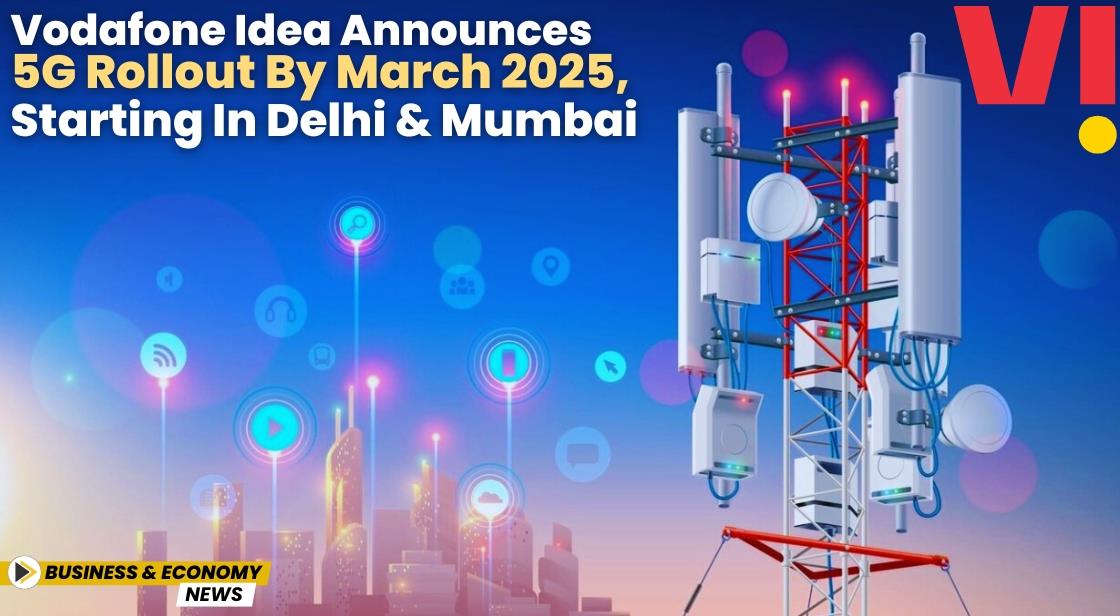Vodafone Idea Announces 5G Rollout by March 2025, Starting in Delhi and Mumbai

News Synopsis
Vodafone Idea (Vi) is preparing to roll out its much-anticipated 5G services by March 2025. The company plans to start the launch in key metropolitan regions, with Delhi and Mumbai being the first cities to receive the upgrade. This rollout will be part of a broader strategy to introduce 5G in 17 regions, focusing primarily on metro areas and major urban centers to cater to high-demand regions.
According to Jagbir Singh, Chief Technology Officer of Vi, this plan will see the company targeting India's most populous and economically significant areas, further reinforcing its position in the telecom market. The plan aligns with Vi's efforts to modernize and enhance its network infrastructure to better compete with the likes of Reliance Jio and Bharti Airtel, both of which have already made strides in their 5G rollouts.
Expanding 4G Coverage to Reach 90% of the Population by 2024
Even as Vi prepares for its 5G launch, the company has ambitious plans for expanding its 4G network. By June 2024, Vodafone Idea aims to extend its 4G coverage to reach 90% of India's population, up from the current coverage of 77%. Presently, the company’s 4G network covers around 1.03 billion people, making this a significant leap in their service expansion.
This aggressive expansion of 4G infrastructure is not only to cater to existing customers but also to position Vi as a more competitive player in the market. By strengthening its network, Vi hopes to provide a better user experience, attract new subscribers, and retain current ones, all while preparing for the eventual transition to 5G.
Jagbir Singh expressed optimism that with these network improvements, the company will stem the loss of subscribers over the coming months, which has been a challenge for Vi in recent years.
Funding to Support Network Expansion and 5G Rollout
To fund its network expansion and 5G rollout, Vodafone Idea raised ₹24,000 crore through equity financing. Of this amount, ₹18,000 crore was raised through a follow-on public offering (FPO). The majority of these funds will be directed toward improving Vi's 4G network, which remains a priority as the company builds a stronger foundation for its eventual 5G services.
This funding is part of Vi’s broader revival plan, which has become necessary as it faces increasing competition from industry giants like Reliance Jio and Bharti Airtel. These funds will not only help in network upgrades but will also support Vi's long-term plans to modernize its infrastructure, ensuring that the company is in a solid position when 5G is finally introduced.
Utilizing Multiple Spectrum Bands for Enhanced Coverage
Vodafone Idea has made significant efforts to enhance its network using all the available spectrum at its disposal. The company is making the most of various spectrum bands, including 900 MHz, 1800 MHz, 2100 MHz, 2300 MHz, and 2500 MHz, to offer better network performance and improved coverage.
The 900 MHz band is a particular focus for Vi due to its superior coverage, especially in densely populated urban areas and indoor environments. By leveraging this band, Vi is aiming to enhance its service quality in cities where network demand is high, while also ensuring that users indoors experience fewer connectivity issues.
To this end, Vi is significantly increasing the number of cell towers utilizing the 900 MHz spectrum. The company plans to expand its cell tower count from 55,000 to 150,000, with 50,000 towers already up and running. Vi expects to complete the rollout of the remaining 50,000 towers within the next nine months, helping to ensure consistent and reliable coverage across India’s urban centers.
Partnerships with Tower Providers and Rollout Timeline
Vodafone Idea has teamed up with several major tower infrastructure providers to support its network expansion. These partners include Indus Towers, ATC, and Tower Vision, who are key to ensuring the timely deployment of the additional towers necessary for Vi’s ambitious plans. So far, Vi has reported no delays in project execution, and the company is set to start utilizing the new towers by November 2024.
However, the company has yet to clarify whether it has resolved outstanding payments to some of its tower partners, such as Indus Towers. These financial obligations remain a critical point as Vi works to ensure that its infrastructure is ready for the upcoming 5G launch.
Phasing Out Chinese Equipment for Network Modernization
In line with its modernization efforts, Vodafone Idea is working to phase out older Chinese-made equipment as part of its network upgrade. The company has already issued requests for proposals (RFPs) to replace outdated Chinese technology and equipment, but it is opting for a gradual process rather than an immediate overhaul.
The transition away from Chinese-origin vendors is expected to take place over the next two years, with Vi focusing on a phased replacement strategy. This will allow the company to maintain operational efficiency while upgrading its infrastructure to meet future demands.
Exploring New Technologies: vRAN and openRAN
As part of its effort to modernize its network, Vodafone Idea is exploring new technologies such as virtualized radio access network (vRAN). Vi has partnered with South Korean tech giant Samsung for vRAN trials in Karnataka, Bihar, and Punjab. This technology is expected to bring greater flexibility and efficiency to the network, improving overall performance and scalability.
However, Vi's experiments with open radio access network (openRAN) technology have not been as promising. Despite deploying openRAN in 25 sites in Jalandhar with the help of US-based Mavenir, the company encountered higher-than-expected costs and technical issues. These challenges have led to a disappointing outcome for openRAN, prompting Vi to shift its focus toward more reliable alternatives.
Conclusion
Vodafone Idea’s ambitious plan to launch 5G by March 2025, coupled with its efforts to expand 4G coverage, demonstrates the company’s commitment to enhancing its network infrastructure. With strategic partnerships, spectrum utilization, and network modernization, Vi is positioning itself to compete effectively in India’s telecom market. Although challenges remain, Vi's focus on innovation and expansion may allow it to regain a stronger foothold in the industry.
You May Like









